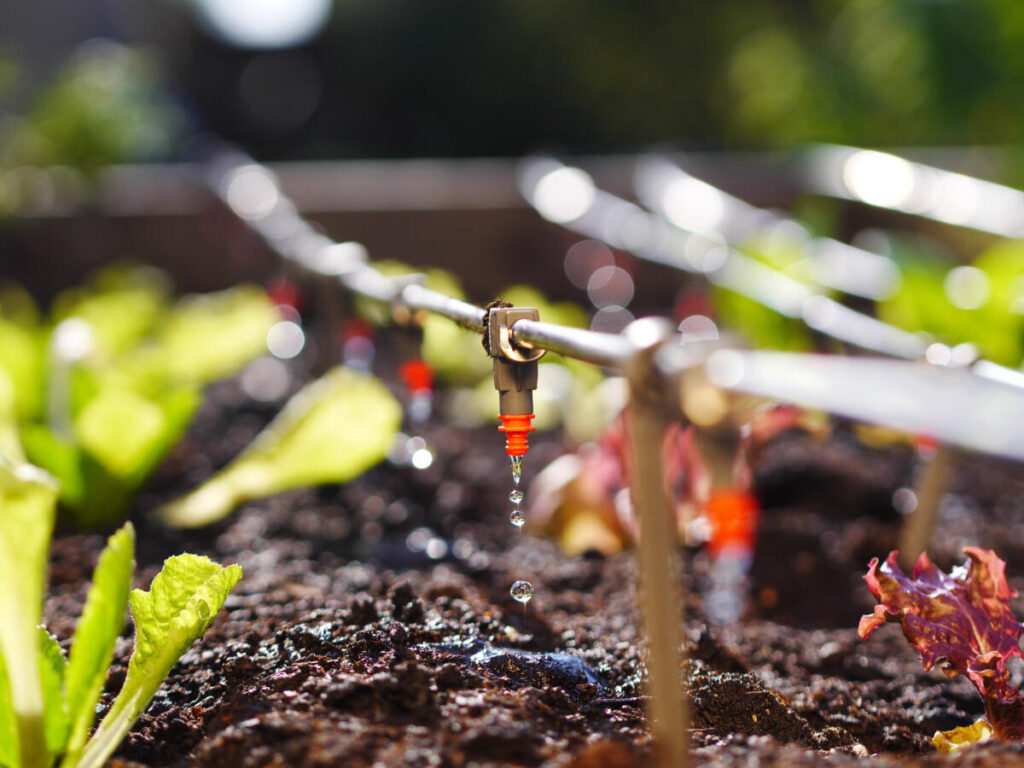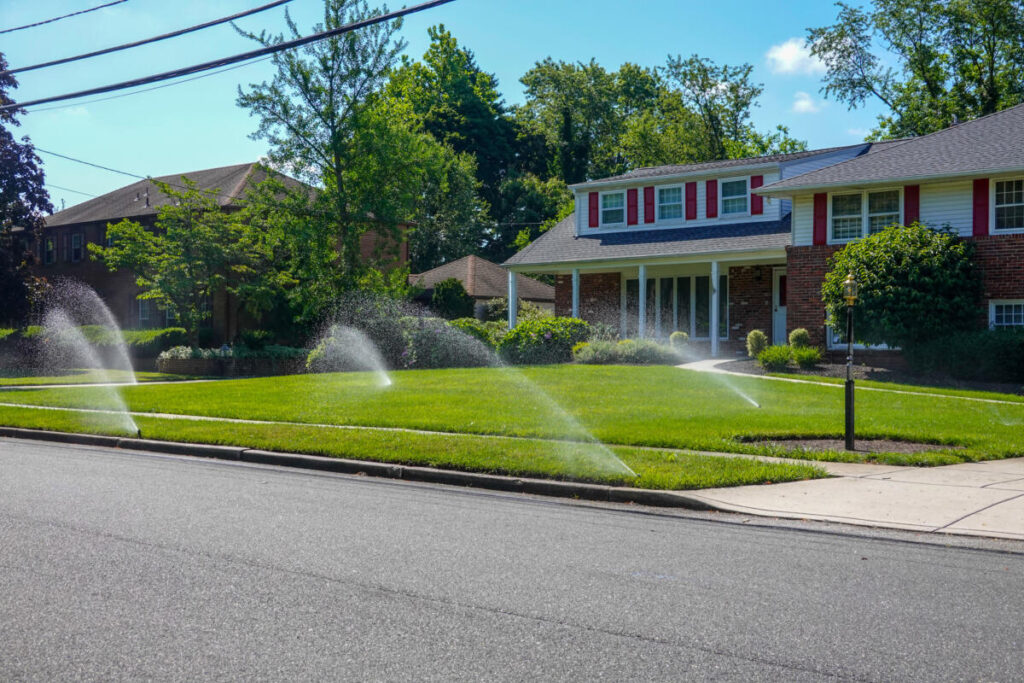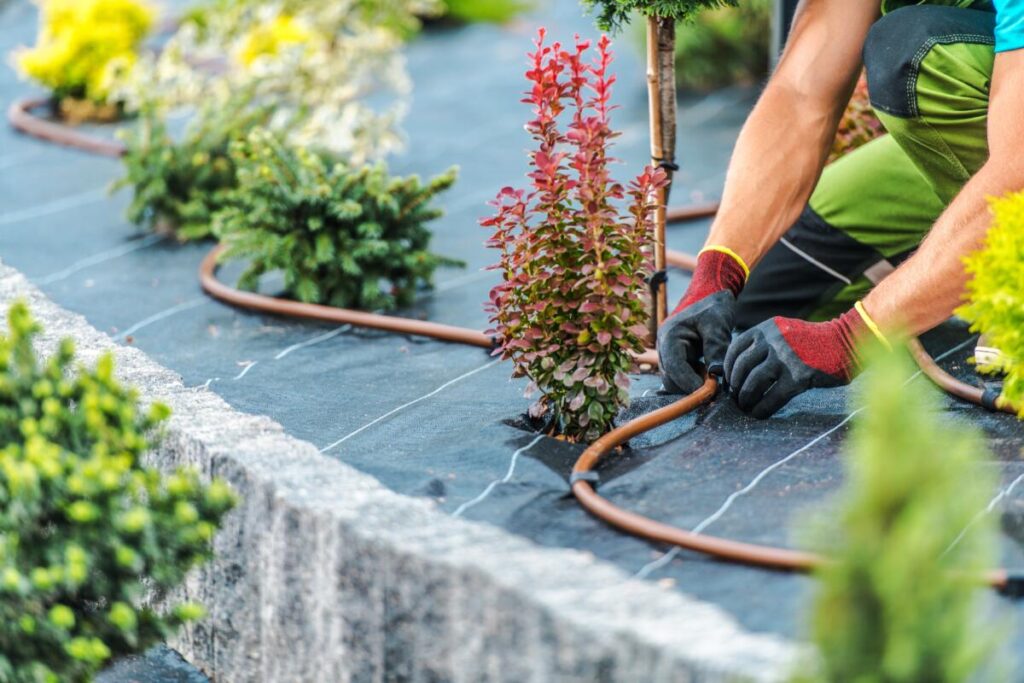Imagine a lush, green landscape that not only looks beautiful, but also conserves water and saves you money on utility bills. Sound too good to be true? With the right landscape irrigation system, you can achieve this dream. Whether you’re a seasoned gardener or just starting to dabble in the world of landscaping, understanding the essentials of irrigation systems, the benefits of drip irrigation can help you create a thriving and sustainable outdoor space. Let’s dive into everything you need to know about landscape irrigation systems!
Quick Overview of Landscape Irrigation Systems
- Most landscape irrigation systems are broken down into three main parts: water source, distribution method and control devices for optimal efficiency.
- Drip irrigation systems offer cost-effective advantages such as precise watering and water conservation.
- Sprinkler systems
- Regular inspections, leak detection & seasonal adjustments are strongly recommended to maintain an efficient & sustainable system.
Table of Contents
Irrigation System Essentials
The foundation of any successful landscape irrigation system lies in three essential components: the water source, the distribution method, and the control devices. Choosing the right water source is crucial, as it can significantly impact the performance and efficiency of your irrigation system. Furthermore, selecting the appropriate distribution method, such as surface, drip, or sprinkler irrigation, ensures that water is applied effectively to your plants. Finally, control devices like timers, controllers, and sensors help manage your irrigation system for optimal efficiency.
Among the various types of irrigation systems, drip irrigation and sprinkler systems are the most popular choices for homeowners. Drip irrigation delivers water directly to the plant’s base through a series of pipes and tubing, making it an efficient and precise method of watering. On the other hand, sprinkler systems distribute water through a network of sprinkler heads, providing a broader coverage across your landscape. Deciding between these systems depends on factors such as cost, local climate, and the specific needs of your plants.
Water Source
Selecting the appropriate water source for your irrigation system is vital to its effectiveness and efficiency. Various water sources can be used for landscape irrigation, including treated water, private well water, recycled water, groundwater, surface water, and city water. Each water source comes with its own set of advantages and disadvantages, depending on the specific requirements of your landscape and native plants.
When choosing the optimal water source for your irrigation system, consider factors such as cost, reliability, availability, and quality. For example, if you live in an area with clay soil, certain water sources may be more suitable than others due to their specific mineral content. By selecting the right water source, you can ensure your landscape receives the appropriate amount of water, reducing overall water usage and promoting a healthier, more sustainable environment.
Distribution Method
There are three primary types of irrigation systems: surface, drip, and sprinkler irrigation. Surface irrigation is relatively low cost and easy to install, but it is highly inefficient, labor-intensive, and often results in uneven water distribution. Drip irrigation systems, on the other hand, are more efficient and can be automated, allowing you to customize watering based on individual plant needs.
Sprinkler irrigation systems share many of the advantages of drip irrigation, such as increased efficiency and automation potential, but they tend to be more expensive and require more maintenance. Choosing the right distribution method for your landscape not only affects the health of your plants, but also plays a significant role in water conservation and the overall performance of your irrigation system.
By selecting the appropriate distribution method based on your landscape’s size, plant types, and watering requirements, you can ensure that your irrigation system operates efficiently and effectively.
Control Devices
Control devices, such as timers, controllers, and sensors, play a crucial role in managing your irrigation system effectively. They allow you to regulate the amount of water used, the timing of irrigation, and the amount of water applied to each zone. For example, an irrigation controller is responsible for activating and deactivating the various valves for the irrigation zones in your yard, while establishing irrigation run times is critical for landscape health and water conservation.
Hydrozones, which categorize plants according to their water requirements, provide distinct irrigation zones for each classification. By utilizing control devices to manage these zones and optimize watering schedules, you can ensure your landscape thrives while minimizing water waste and conserving valuable resources.

Drip Irrigation Advantages
Drip irrigation systems offer numerous benefits for homeowners seeking a more efficient and precise method of watering their landscape. These systems deliver water directly to the root zone of the plant at low pressure and low volume, ensuring efficient water usage. Drip irrigation is not only cost-effective and easy to install compared to overhead sprinkler systems, but it can also help reduce the risk of diseases caused by excessive moisture in certain plants.
Moreover, the primary objective of installing a water-wise landscape is to minimize the requirement for additional irrigation while maintaining a healthy and aesthetically pleasing landscape. By utilizing drip irrigation systems, you can achieve this goal and enjoy the advantages of water conservation, precise watering, and adaptability to various landscape types.
Water Conservation
Water conservation is an essential aspect of sustainable water management and is necessary for preserving healthy ecosystems. Drip irrigation systems have been demonstrated to reduce water use by 30 to 70 percent in comparison to conventional sprinkler irrigation. By delivering water directly to the plant root zone and mitigating runoff and evaporation, drip irrigation systems eliminate waste and conserve valuable water resources.
In addition to using drip irrigation systems, homeowners can further reduce their water use by incorporating water-efficient fixtures, harvesting rainwater, utilizing mulch and other soil amendments, and planting drought-resistant plants in their landscape, including vegetable gardens. By adopting these water conservation practices, you can create a more sustainable and eco-friendly outdoor space.
Precise Watering
One of the key advantages of drip irrigation systems is their ability to provide precise watering to specific plants or areas. By delivering water directly to the roots of plants through small tubing with emitters spaced along the line, drip irrigation systems ensure efficient water usage. This targeted watering approach not only minimizes water waste but also promotes healthier plant growth by providing the exact amount of water required by each plant.
Drip irrigation systems are available in two primary types: subsurface and above-ground systems. Both types can be easily adapted to suit different landscapes, plant needs, and root systems, allowing you to create an irrigation system that perfectly meets the unique requirements of your outdoor space.
Adaptability
Drip irrigation systems, also known as drip systems, offer a high level of adaptability, making them an ideal choice for a wide range of landscape types and plant needs. By laying tubing with emitters close to the plants, utilizing subsurface or mulch drip tubing, designing and installing drip irrigation systems on sloped terrains, and creating a network of plastic pipes to carry a low flow of water under low pressure to the plants, drip irrigation systems can be tailored to suit the specific requirements of your landscape.
The benefits of utilizing drip irrigation for various landscapes include enhanced water efficiency, decreased water runoff, and enhanced plant health. By choosing a drip irrigation system that is adaptable to your landscape’s unique needs, you can create a more efficient and sustainable watering solution for your outdoor space.

Sprinkler System Options
In addition to drip irrigation systems, other popular options for landscape irrigation include rotary sprinklers, spray heads, and pop-up sprinklers. Each of these sprinkler system types offers its own set of advantages and disadvantages, making them more suitable for specific landscape types and watering needs, such as a lawn irrigation system.
By understanding the key features and benefits of each sprinkler system option, you can make an informed decision about the best irrigation system for your yard. Whether you require a system that covers a large area with a single sprinkler head, like rotary sprinklers, or a more targeted approach for smaller spaces, such as spray heads and pop-up sprinklers, there is a sprinkler system that will perfectly meet your needs.
Rotary Sprinklers
Rotary sprinklers distribute water in a circular pattern and are ideal for large, open areas due to their ability to provide broad coverage with a single sprinkler head. These sprinklers offer numerous benefits, including a low precipitation rate that ensures even water distribution, increased efficiency compared to other sprinklers, suitability for larger gardens and uneven ground, and minimal maintenance requirements.
However, rotary sprinklers may not be suitable for small areas, can be more expensive than other types of sprinklers, and can be difficult to install.
Spray Heads
Spray head sprinklers emit a fixed spray pattern, making them ideal for smaller areas. They offer several advantages, such as delivering water at a faster rate than other sprinklers, providing an even and consistent spray pattern, and being fitted with pressure-regulating features.
However, one potential drawback of spray heads is the heightened risk of overwatering plants. To ensure optimal performance, it is important to utilize spray heads in areas that require a balanced distribution of water, such as flower beds or small lawns (not on the edge between two sections that need to be watered at different rates). For the best coverage, install spray heads at least 10 feet apart.
Pop-up Sprinklers
Pop-up sprinklers are a type of irrigation system that remains hidden when not in use, providing an aesthetically pleasing landscape with the ease of watering. These sprinkler systems offer numerous benefits, including price, convenience, simple installation, and attractive design.
The installation is very similar to other systems where the water lines are installed, these are then connected to the sprinkler heads and a water supply line, and then a final line is added connecting the system to a control device, such as a timer or modern controller.
The main downside to pop-ups is the sprinkler headers can get clogged, blocked by debris, or damaged. To ensure optimal performance, regular maintenance of pop-up sprinklers should include inspecting the system for leaks, examining the sprinkler heads for clogs or damage, and adjusting the system for seasonal changes.
Smart Irrigation Technology
In recent years, advancements in smart irrigation technology have revolutionized the way we manage our landscape watering needs. From smart controllers that automatically adjust watering schedules based on factors such as weather conditions and plant needs, to moisture sensors that optimize irrigation efficiency by detecting soil moisture levels and adjusting watering accordingly, these innovative technologies provide a more precise and efficient approach to landscape irrigation.
By incorporating smart irrigation technology into your landscape watering system, you can not only conserve water and save money on your utility bills, but also promote healthier plant growth and a more sustainable outdoor environment. Let’s explore some of the latest advancements in smart irrigation technology and how they can benefit your landscape.
Smart Controllers
Smart controllers are devices that can be connected to an irrigation system to automatically adjust the watering schedule based on factors such as weather conditions and plant requirements. These controllers offer numerous advantages, including water conservation, improved landscape health, convenience, cost savings, and simplified irrigation scheduling.
Smart controllers function by utilizing sensors to assess variables such as soil moisture, temperature, and sunlight, and then use this data to modify the watering schedule accordingly. For example, if the soil is already moist, the controller will decrease the amount of water applied.
While the cost of smart controllers can vary depending on the features and capabilities of the controller, the potential savings in water usage and utility bills often outweigh the initial investment.
Moisture Sensors
Moisture sensors are devices that measure the amount of moisture present in the soil, helping to optimize irrigation efficiency by detecting soil moisture levels and adjusting watering accordingly. By ensuring that plants are only watered when necessary, moisture sensors can help minimize water consumption and save time spent manually adjusting irrigation systems.
There are two main types of moisture sensors available: capacitive and resistive. Installing moisture sensors is a straightforward process that involves inserting the sensor into the soil at the desired depth, connecting it to the irrigation system’s controller, and programming the controller to adjust the watering schedule based on the sensor’s readings.
By incorporating moisture sensors into your irrigation system, you can further enhance its efficiency and conserve valuable water resources through supplemental irrigation.
Weather-based Adjustments
Incorporating weather data into your irrigation system can lead to more precise and efficient watering schedules. Weather-based adjustments, such as modifying irrigation based on temperature, humidity, and precipitation, allow for more accurate watering schedules that take into account the unique conditions of your landscape.
A smart controller can be utilized to incorporate weather data into your irrigation system by programming the controller to adjust the system based on the weather data. By taking advantage of weather-based adjustments, you can enjoy the benefits of enhanced efficiency, cost savings, environmental sustainability, heightened effectiveness, and precise forecasting, ultimately creating a more sustainable and eco-friendly outdoor space.

Landscape Irrigation Maintenance
Regular maintenance is essential for ensuring the proper functioning and efficiency of your irrigation system. By routinely inspecting your system for leaks, clogs, or other issues, and adjusting the system settings based on seasonal changes, you can avoid expensive repairs and maintain a healthy, thriving landscape.
In addition to regular inspections and leak detection, other important maintenance steps for your irrigation system include scheduling irrigation based on the water needs of each irrigation zone, setting up an irrigation controller, and making seasonal adjustments. By keeping up with these maintenance tasks, you can ensure that your irrigation system remains in top condition, conserves water, and promotes a sustainable outdoor environment.
Adding irrigation system checks to your long list of yard maintenance tasks can be daunting, but we strongly encourage homeowners to take them seriously. This is why we include irrigation system checks in all of our yard maintenance services. Not only do they extend the life of your system, but they help conserve water and ensure your plants are getting the perfect amount of water.
If you plan on doing these yourself, here’s everything you should check on:
Regular Inspections
Conducting regular inspections of your irrigation system is crucial for ensuring its optimal performance and identifying any potential issues early, thus avoiding expensive repairs in the future. During these inspections, it is important to assess the entire system, including sprinklers, valves, and pipes, as well as inspect for any signs of deterioration, and ensure that the system is correctly adjusted for the season.
It is recommended that regular inspections take place at least once a year, or more frequently if the system is utilized on a regular basis. By staying on top of regular inspections, you can catch potential problems early, saving you time and money in the long run.
Leak Detection
Detecting and repairing leaks in your irrigation system is essential for preventing water waste, saving money, protecting your landscape, avoiding property damage, and promoting water conservation. Signs of a potential leak in your irrigation system may include an increase in your water bill without an apparent cause, a decrease in the system’s performance, dry spots, soggy areas in the yard, overgrown turf, erosion, and/or subsidence.
To detect leaks in drip irrigation systems, visually inspect the drip lines while the system is running. By identifying and addressing leaks in a timely manner, you can prevent costly repairs and maintain the health and beauty of your landscape.
Seasonal Adjustments
Adjusting your irrigation system’s watering schedule and settings in accordance with seasonal changes can ensure that your landscape receives the appropriate amount of water throughout the year. Implementing an effective irrigation schedule can help you adapt to seasonal fluctuations in weather and vegetation requirements, which have a direct impact on the amount of water needed for your landscape, making it crucial to adjust your irrigation system accordingly.
How to Get the Most Out of Your Home Irrigation System
A quality home irrigation system can make maintaining a beautiful yard significantly easier. Whether you choose an advanced smart system with pop up sprinklers, or opt for a DIY drip system, you will start saving time and money right away.
The key to getting the most out of your irrigation system is to take the time to research and select the right system for your yard. A large yard with complex landscaping with a multitude of different plants will require a vastly different system than a small front yard in the city. This is where the experts at Three Timbers can help. Our team is here to guide you through the selection process, educating you on everything you need to know to make the best decision. Once everything is selected, we will help install the system so it will work at optimal efficiency from day one. This way, you can rest easy knowing your yard is getting the perfect amount of water without lifting a finger.
If you happen to be located in Minnesota (Chanhassen and surrounding area) or Arizona (near Scottsdale or Chandler) our team is at the ready to help you find the perfect irrigation system for your home. Contact us today to learn more!


